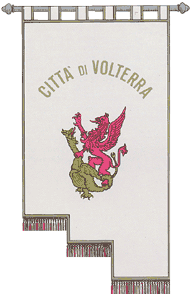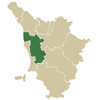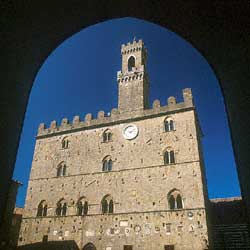|  Inhabitants in 1991: 12.879
Inhabitants in 1991: 12.879
 Situated
on a hilly spur between the valley dell’Era and the valley del Cecina,
the municipal territory extends for 2523,85 square kilometres, in an area
characterised by erosion phenomena (crags). A Leopoldino municipality,
in its present day extension it however suffered territorial reductions
in 1869 and 1919. Situated
on a hilly spur between the valley dell’Era and the valley del Cecina,
the municipal territory extends for 2523,85 square kilometres, in an area
characterised by erosion phenomena (crags). A Leopoldino municipality,
in its present day extension it however suffered territorial reductions
in 1869 and 1919.
Founded by the Etruscans, Volterra was one of the twelve Lucumonie
of Etruria and, above all from the IV century B.C., a rich economic and
commercial centre. In the Etruscan defensive system, against the Roman
pressures from the south, the advance of the Gauls in the Emilana region,
the raids by the Liguri populations, the city became the most important
strategic base of the lower valley of the Arno. Going back to these
times are the imposing remains of the walls, the Templar finds, the vast
suburban necropolis of Badia, Portone and Ulimeto. The political and cultural
influence of the urban centre extended over all the territory comprised,
approximately, between the rivers Pesa, and Arno , and the Tirreno sea.
Definitively subjugated to Rome around 260 B.C., Volterra constituted
a conspicuous municipality endowed with extensive autonomy. Towards the
end of the second Punic War (205B.C.) we find Volterrani among the eight
populations of the dissolved Etruscan twelve cities who sent grain, arms
and naval equipment to Consul Publio Cornelio Scipione.
 In
the civil war between Mario and Silla the city suffered a long siege
(82-80B.C.), and the conquest and sever reprisals on the part of the Sillani.
With the Augusteo territorial organisation it was constituted as one
of the municipals of the VII Region, Etruria. Notwithstanding
several notable public and residential works brought about mainly by the
thrust of certain powerful local families inserted in Roman society, Volterra
did not have a very high position among the cities subjected to Rome,
and cut out of the two large communication roads, the Aurelia and
the Cassia, it also saw reductions in its inhabitants. Dominated by
the Longobardi at the end of the VI century until 774, it was then
subjected to the Franchi. In the X century, in the course of the struggle
between Berengario I, King of Italy and Alberto, Marquis of Toscana, it
was almost completely destroyed; the reconstruction which followed
saw the emergence of the first nucleus of the present day urban structure. In
the civil war between Mario and Silla the city suffered a long siege
(82-80B.C.), and the conquest and sever reprisals on the part of the Sillani.
With the Augusteo territorial organisation it was constituted as one
of the municipals of the VII Region, Etruria. Notwithstanding
several notable public and residential works brought about mainly by the
thrust of certain powerful local families inserted in Roman society, Volterra
did not have a very high position among the cities subjected to Rome,
and cut out of the two large communication roads, the Aurelia and
the Cassia, it also saw reductions in its inhabitants. Dominated by
the Longobardi at the end of the VI century until 774, it was then
subjected to the Franchi. In the X century, in the course of the struggle
between Berengario I, King of Italy and Alberto, Marquis of Toscana, it
was almost completely destroyed; the reconstruction which followed
saw the emergence of the first nucleus of the present day urban structure.
From XI century it was governed by the Bishops, whose authority
was also supported by the Emperor, while the out of town area remained
in the hands of the local Lords. Between these two antagonistic forces,
from the middle of the XII century was outlined the role of municipal,
which after hard conflict with the Bishop managed to impose their first
Podesta in 1193. Under the municipal regime, the face of the city
was transformed: in fact, a new surrounding wall was erected, the Palazzo
del Popolo (then dei Priori) was constructed, the piazza dei Prior was
put in order, finally the Cathedral was finished. Except for a brief period
of Fiorentina domination in 1254, Volterra maintained its independence
and its condition of free municipality until 1340 when it became Lordship
of the Belforti family, driven out in 1361 for having tried to sell
the city to the Pisani. In this era Firenze had long held the dominion
rights, and Volterra became a true Firenze dominion after the anti-Fiorentini
revolts in 1427.
Volterra rebelled again in 1471 and was reconquered the following year
paying the price of a grave siege by the Fiorentini, strongly interested
in controlling the exploitation of the, salt, sulphur, vitriol
and allume mines in which the territory of Voterra was rich. In
the new reality of the institutional rapport the city began slowly to
assume an inferior economical function and was politically more marginal,
this was testified by the population decline and the distancing
of the noble families. A reversal of this tendency came about only in
the 1700s when the new reigning dynasty of Lorena created new
stimuli to the local economy, liberating the exportation of agricultural
products and improving the connection network with the sea and the interior.
It became autonomous community in 1779 with the reform of Leopoldo
I, in 1799 it was upset by internal contrasts among the followers
of the revolutionary French and the restorers. After the Napoleonic domination
(1808-1814) it was re-annexed to the Grand Duchy until the Unity of Italy.
It was an active centre for the Anarchist movement and socialist stronghold
until 1919, it developed a strong clandestine antifascist organisation.
The partisan activity begun in 1943 was reinforced above all after
the formation, in May 1944, of the XXIII Brigade, who recruited all the
forces of the area. In a short time these occupied all the Volterra
hinterland forcing the Germans to retreat at the end of June, after
numerous reprisals. In Volterra one of the most important Etruscan museums
in Italy has its Seat.
Places to visit:
Piazza dei Priori, this vast square goes back to 1200 and forms
one of the most representative urban ambiences from the Medieval era.
It is completely surrounded by ancient and elegant palaces and towers,
in part original in part remodelled.
Palazzo dei Priori, faces onto the same name square; begun
in 1208 and the oldest municipal palace in Toscana.
Palazza Pretorio. Placed opposite the Palazzo dei Priori, it
is a vast and elegant building, composed of diverse 1200 structures,
dominated by the Tower of the Podesta.
Palazzo Vescovile, also found in the Piazza dei Priori,. Initially
was used as a public granary it was transformed in 1472 into Episcopal
residence.
Picture Gallery and Civic Museum, among the many masterpieces
exhibited in this rich museum, is the supreme work of the 1500s Rosso
Fiorentino: Deposizione della Croce.
Guarnacci Etruscan Museum, hosted since 1877 in the elegant
Palazzo Desideri-Tangassi, there are numerous extremely interesting
finds collected there, so much so it has the fame of one of the most
important Etruscan collections in Italy.
Vallebuona Archaeological Area, where it is possible to admire
the suggestive remains (from IV century B.C.) of the Roman theatre
and the thermal building.
The Cathedral, consecrated in 1120 it was enlarged and transformed
in the successive centuries, with 1500 Latin cross, three nave interior.
The lacunar with busts of Saints is the work of Jacopo Paolini. Among
the many works of art present there, stands out La Deposizione multicoloured
wooden group from 1228.
Baptistery, placed opposite the Cathedral, it is of octagonal
plan. The interior preserves a marvellous baptismal font by Andrea
Sansovino. |
Historical info reproduced upon authorization of
Regione Toscana - Dipartimento della Presidenza E Affari Legislativi e
Giuridici
Picture by Sandro Santioli
Translated by Ann Mountford
|